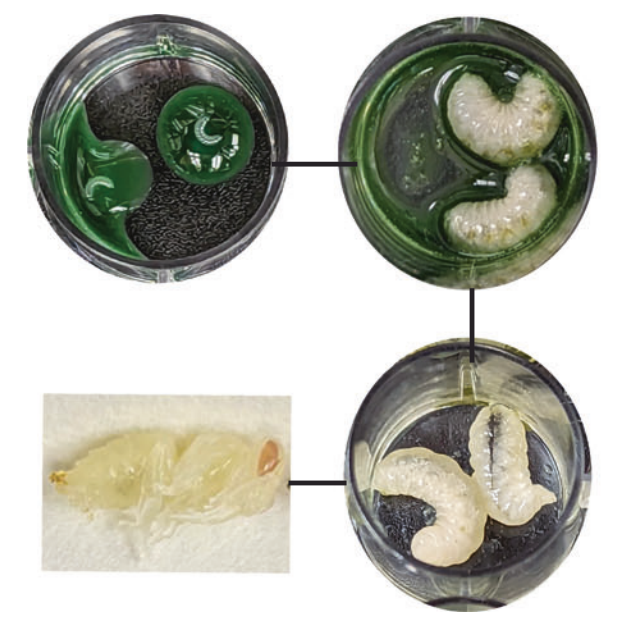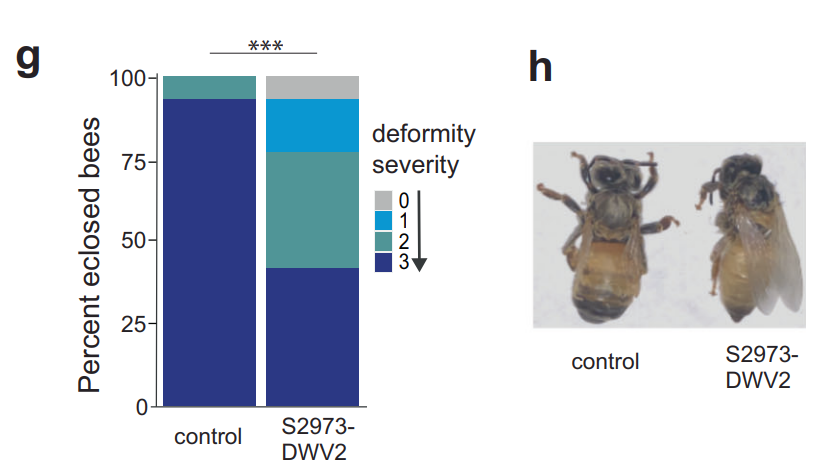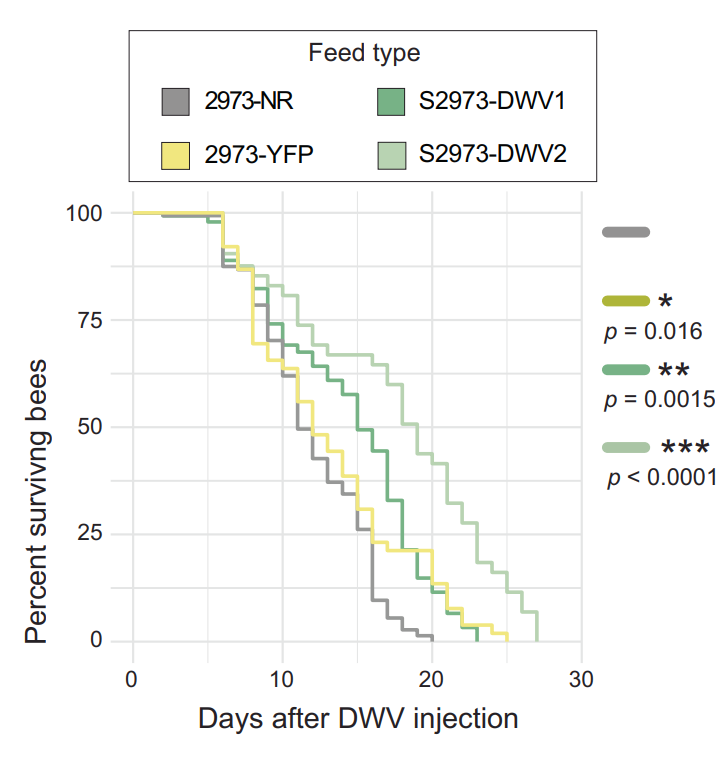
In part of the recent study, groups of larvae were fed diets containing different strains of blue-green algae that either had or had not been engineered to fight DWV using RNAi. They were raised to pupae, and then injected with a controlled quantity of virus. (See figure source citation below.)
A recent research paper has shown that genetically engineered cyanobacteria (blue-green algae) can reduce levels of deformed wing virus (DWV) when fed directly to honey bees. This work was done by scientists at the USDA-ARS Honey Bee Breeding, Genetics, and Physiology Research lab in Baton Rouge, Louisiana. The research was conducted by a team of scientists, led by Dr. Vincent Ricigliano. The open-access paper is freely available to anyone who wants to read it.
Briefly, the scientists engineered blue-green algae cells to produce a piece of genetic code that targets DWV, preventing the virus from hijacking the bees' cells. Feeding this genetically engineered blue-green algae to bees who were then injected with DWV extended their lifespans and protected them from the severe effects of DWV. This inexpensive engineered blue-green algae could represent a powerful new tool in the fight against mites and mite-transmitted viruses. That is if it can make the technical and legal transition out of the laboratory and into the hands of beekeepers.
Quick genetics: DNA and mRNA
Inside a honey bee (or human) cell, the genetic information is stored as two strands of DNA, matched to each other and coiled around one another. When the cell needs to make a protein based on part of that genetic code, it unwraps and "reads" the DNA and makes a copy of it to carry information from the DNA to the parts of the cell that manufacture proteins. The message-carrying copy is a "messenger RNA molecule" or mRNA, which is a kind of temporary copy of a section of DNA code.
You can think of DNA as the great big family recipe book that explains how to make all of your family's favorite dishes, and mRNA as your Post-It note copy of just one particular recipe that you'll stick to the counter while you're cooking dinner tonight.
Viruses
When a virus invades a cell, it injects its own genetic material and forces the cell to make virus proteins using the cell's own protein-making machinery. Whether a virus injects DNA or RNA (different viruses use different molecules), ultimately it's trying to produce its own mRNA molecules that will carry instructions to the host cell for the construction of viral proteins. This will overwhelm and usually kill the host cell, and so is something worth preventing.
RNAi
So, a healthy cell makes mRNA molecules to guide the making of normal proteins. Viruses also use mRNA molecules to guide the making of viral proteins. The blue-green algae cells in this study were engineered to trigger the production of yet another molecule called RNAi, or "interference RNA." These RNAi molecules interfere with the mRNA of the viruses, interrupting their attempt to hijack the cell's own machinery. The RNAi system is a key part of the immune system of honey bee cells (as well as human cells) and helps to keep viruses under control. The engineered blue-green algae in the study contained targeted molecules that were focused on interfering with the activity of deformed wing virus.

After pupae were injected they developed into adult workers. The scientists scored how severe their wing deformities were, and reported that the vast majority of the eclosed (emerged) bees fed a non-engineered control diet had very severe wing deformities, while the bees fed the genetically engineered strain (S2973-DWV2) had much less deformity even after receiving a large injection of virus. (See figure source citation below.)
Feeding bees engineered cells
Blue-green algae has been studied for years as a possible bee feed, since the nutritional profile of blue-green algae is not very different from that of pollen. Mixing blue-green algae into protein patties has been examined as a promising way to help feed bees without having to harvest pollen. Because blue-green algae cells are also quite easy to manipulate with genetic engineering, this research isn't a terribly surprising attempt to use those tools to help honey bee health.
Not just any algae!
As soon as this paper was published, beekeeping forums filled up with beekeepers describing their plans to pour green pond water into their bee feeders, to help fight viruses. This is the real danger of oversimplifying science, or getting your genetic engineering news from a beekeeper online and not a trusted source of information. Of course, pond scum won't help your bees fight off viruses, because the strains of blue-green algae used in this study were only effective because they carried the engineered genes meant to target the viruses. Normal blue-green algae cells (let alone whatever is making the water green in your backyard fish pond) will have no effect on the virus levels in your hives.

The bees fed engineered anti-DWV blue-green algae strains (S2973-DWV1 and S2973-DWV2) survived longer than the bees fed two other diets (2973-NR and 2973-YFP) that were not engineered to help fight DWV infection. (See figure source citation below.)
Another RNAi technology on the horizon: Norroa
A completely different product heading towards U.S. markets is also based on RNAi technology. Greenlight Biosciences is working to bring a product called Norroa ( formerly called Vadescana) to U.S., Canadian, E.U., Australian, and New Zealand markets. How does it work? Good old RNAi again! In Norroa, the bees mix the proprietary double-stranded RNA into the brood food, where varroa mites hide as they wait for a brood cell to be capped. The mites absorb some of the RNA, which leads to the production of RNAi molecules inside the mites' cells. The mites aren't directly killed, but they are prevented from reproducing, which keeps the mite population from growing in your hives.
The prospect of gene-based technologies in bee health
These interesting RNAi-based technologies are fascinating and exciting leaps forward in bee health technology, but you can't buy either of them from your favorite beekeeping supplier just yet. Genetic engineering is powerful, but can also be dangerous if it isn't carefully tested and perfected before it leaves the laboratory. For now, virus-fighting engineered blue-green algae is an interesting line of research to keep a close eye on. A product like mite-sterilizing Norroa is closer to passing the necessary regulatory review, but it is also not going to be available to treat your mites this season.
For now, we all need to rely on approved and legal miticides and mite management techniques (like brood breaks and drone comb trapping) until these new technologies prove themselves in the field and satisfy the regulators that determine when a new tool is safe.
Learning about these new tools now, while they're still being developed, will get us ready to use them if and when they become available for use in our own apiaries - if we decide that they're right for us and our bees.
Figures modified from original publication under a Creative Commons Attribution 4.0 International License: http://creativecommons.org/licenses/by/4.0/ Source: Ricigliano, V.A., McMenamin, A., Martin Ewert, A. et al. Green biomanufacturing of edible antiviral therapeutics for managed pollinators. npj Sustain. Agric. 2, 4 (2024). https://doi.org/10.1038/s44264-024-00011-7



